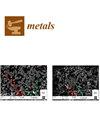Additive Manufacturing of Metal Materials for Construction Engineering: An Overview on Technologies and Applications
IF 2.5
3区 材料科学
Q3 MATERIALS SCIENCE, MULTIDISCIPLINARY
引用次数: 0
Abstract
Additive manufacturing, better known as 3D printing, is an innovative manufacturing technique which allows the production of parts, with complex and challenging shapes, layer by layer mainly through melting powder particles (metallic, polymeric, or composite) or extruding material in the form of wire, depending on the specific technique. Three-dimensional printing is already widely employed in several sectors, especially aerospace and automotive, although its large-scale use still requires the gain of know-how and to overcome certain limitations related to the production process and high costs. In particular, this innovative technology aims to overtake some of the shortcomings of conventional production methods and to obtain many additional advantages, such as reduction in material consumption and waste production, high level of customisation and automation, environmental sustainability, great design freedom, and reduction in stockpiles. This article aims to give a detailed review of the state of scientific research and progress in the industrial field of metal additive manufacturing, with a detailed view to its potential use in civil engineering and construction. After a comprehensive overview of the current most adopted additive manufacturing techniques, the fundamental printing process parameters to achieve successful results in terms of quality, precision, and strength are debated. Then, the already existing applications of metal 3D printing in the field of construction and civil engineering are widely discussed. Moreover, the strategic potentiality of the use of additive manufacturing both combined with topological optimisation and for the eventual repair of existing structures is presented. It can be stated that the discussed findings led us to conclude that the use of metal additive manufacturing in the building sector is very promising because of the several benefits that this technology is able to offer.用于建筑工程的金属材料快速成型技术:技术与应用概述
增材制造(又称三维打印)是一种创新的制造技术,主要通过熔化粉末颗粒(金属、聚合物或复合材料)或以线材形式挤出材料(取决于具体技术),逐层生产形状复杂且具有挑战性的零件。三维打印技术已在多个领域得到广泛应用,尤其是航空航天和汽车行业,但要大规模使用这种技术,仍需要掌握专门技术,并克服与生产工艺和高成本有关的某些限制。特别是,这种创新技术旨在克服传统生产方法的一些缺点,并获得许多额外的优势,如减少材料消耗和废物产生、高度定制化和自动化、环境可持续性、极大的设计自由度和减少库存。本文旨在对金属快速成型工业领域的科研现状和进展进行详细综述,并对其在土木工程和建筑领域的潜在应用进行详细分析。在对当前最常用的增材制造技术进行全面概述后,文章对在质量、精度和强度方面取得成功结果的基本打印工艺参数进行了讨论。然后,广泛讨论了金属三维打印在建筑和土木工程领域的现有应用。此外,还介绍了结合拓扑优化使用增材制造技术以及最终修复现有结构的战略潜力。可以说,讨论的结果使我们得出结论,金属增材制造技术在建筑领域的应用前景非常广阔,因为这项技术能够提供多种益处。
本文章由计算机程序翻译,如有差异,请以英文原文为准。
求助全文
约1分钟内获得全文
求助全文
来源期刊

Metals
MATERIALS SCIENCE, MULTIDISCIPLINARY-METALLURGY & METALLURGICAL ENGINEERING
CiteScore
4.90
自引率
13.80%
发文量
1832
审稿时长
1.5 months
期刊介绍:
Metals (ISSN 2075-4701) is an open access journal of related scientific research and technology development. It publishes reviews, regular research papers (articles) and short communications. Our aim is to encourage scientists to publish their experimental and theoretical results in as much detail as possible. Therefore, there is no restriction on the length of the papers. The full experimental details must be provided so that the results can be reproduced. Metals provides a forum for publishing papers which advance the in-depth understanding of the relationship between the structure, the properties or the functions of all kinds of metals.
 求助内容:
求助内容: 应助结果提醒方式:
应助结果提醒方式:


